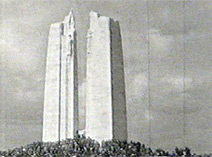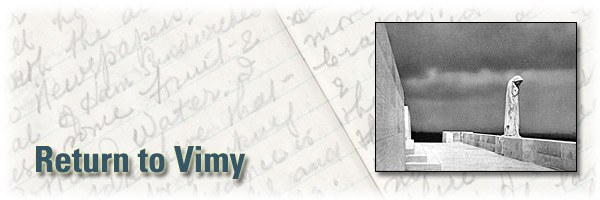
In August of 1935, John Mould and his wife Edith attended the Canadian National Exhibition.
![Photo: Midway at the Canadian National Exhibition (CNE), [ca. 1930]](pics/4196_cne_midway_270.jpg)
Click to see a larger image (81K)
Midway at the Canadian National
Exhibition (CNE), [ca. 1930]
Ministry of Education
Black and white print
Reference Code: RG 2-71 COT-102
Archives of Ontario, I0004196
As they enjoyed the fair John may well have been recalling those days some 21 years earlier when he had received his military training on this very site. They noticed a something called the “Vimy Pilgrimage Booth,” and looking in, John recognized an old acquaintance, Captain Fairweather of the 19th Battalion. The Captain was booking passages for an upcoming trip to re-visit the old battlefields of France and Belgium. The highlight of the trip was to be the unveiling of the monument to Canadian veterans at Vimy Ridge.
John decided that the family should take the trip, and he immediately paid the $10 deposit for his daughter Audrey, Edith and himself. As he describes in the final volume of his diary, the eleven months they had to wait until crossing the ocean for Europe, “seemed to drag on so slowly that we thought July 15th, 1936 would never come.”
Finally, however, the day came, and John and 11,000 other pilgrims sailed off for their destination.
They arrived at Le Havre on July 24th and the passengers were loaded onto more than 100 buses that were to take them through some of the battle sites, including Amiens, Arras and Douai on their way to Lille, which was their stopping place. The next day, the journey continued, and they crossed the border into Belgium.
The pilgrims drove around all that day, visiting cemeteries and monuments to the fallen until finally, after more than 15 hours of driving, they were taken to Arras, their resting place for the night. This was after more than fifteen hours of driving, and the most important part of their journey was still to come the next day: the unveiling of the Vimy Memorial.
“Leaving here the next interesting point was Kemmel Hill which could be seen quite plainly in the distance. Next we came to Wytschaete and after that Ypres. Everyone was curious to see how this never to be forgotten city would look after twenty years of peace, and were quite surprised when they saw that most of Cloth Hall was still in ruins. They have built the tower up again and a little of the front, but most of it is just as it was left during the war.”
John Mould's Diary
Excerpt from Vol. 9, pp. 36-37, 1936
John F. Mould fonds
Reference Code: F 954
Archives of Ontario
Click here to listen to an excerpt from the diary in "wav" format (1.1Mb). It is also available in "aif" format (1.1Mb).
On July 26th 1936, the 100 buses again took off carrying the pilgrims to Vimy Ridge. On their way they passed hundreds of Frenchmen and their families along the road, who were also heading for the memorial. When they arrived, they had their lunch.
“Feeling
a little refreshed after our rest, the next thing we did
was to get a closer view of the monument, it being some
three or four hundred yards from where we had been sitting.
It was during this walk that scenes of the old war days
came back to me more than ever. Huge craters, shell holes
and barbed wire were there, the same as they had been left
on those April days nineteen years ago. There had been quite
a lot of wet weather during the last month in France and
this made the ground rather slippy to walk on. It is the
same old clay we used to get during our trips into the trenches,
and the continuous walking in and out of the shell holes
and over barbed wire made the women rather tired. I heard
one woman say: ‘No wonder they called it No Man’s
Land, I can understand it now’. I wonder what she
would have said about it twenty years ago when we had to
plough through fields of mud and slush up to our knees.
Still it was a little reminder of what we had to go through
just the same.
To the delight of the vast number
of French spectators and also to the many French-speaking
Canadians who were amongst the Pilgrims, the King spoke
a short time in French. For a few seconds the King, with
his head uncovered and his fair hair tossed by the gentle
breeze, looked down gravely and rather sadly at the blind
and crippled, and also at his old comrades, some who had
been with him on this very front – the front where
he had received his first real trial of manhood.”
John Mould's Diary
Excerpt from Vol. 9, pp. 45-48 and
66-67, 1936
John F. Mould fonds
Reference Code: F 954
Archives of Ontario
Click here to listen to an excerpt from the
diary in "wav" format (1.7Mb).
It is also available in "aif"
format (1.7Mb).
Not long afterwards, King Edward VIII arrived at the Memorial grounds
and began to walk amongst the throngs of people waiting to hear
his speech. He shook hands and chatted with many veterans, and
made a special point of speaking with Mrs. Woods of Winnipeg,
a staunch lady of 75 who had sent twelve sons to the War with
only five of them returning. The King met President Lebrun of
France and they made their way to the platform that overlooked
the veiled figure of Canada on the Monument.
Of the monument itself, Mould records the King as saying:
“It is the inspired expression in stone, chiselled by a skilful Canadian hand, of Canada’s Salute to her fallen sons. It marks the scene of feats of arms, which history will long remember and Canada can never forget. And the ground it covers is the Gift of France to Canada. All the world over, there are battlefields, the names of which are written indelibly on the pages of our troubled human story. It is one of the consolations which time brings, that deeds of valour, done on those battlefields, long survive the quarrels, which drove the opposing hosts to conflict.”
John Mould's Diary
Excerpt from Vol. 9, pp. 62-63,
1936
John F. Mould fonds
Reference Code: F 954
Archives of Ontario
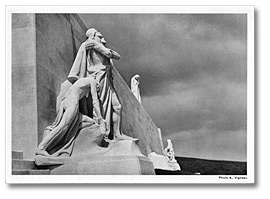
Click to see a larger image (65K)
Statue at the Vimy Memorial
A. Vigneau
Postcard
John F. Mould fonds
Reference Code: F 954
Archives of Ontario, I0024380
Click here to listen to an excerpt from the diary in "wav" format (1.5Mb). It is also available in "aif" format (1.5Mb).
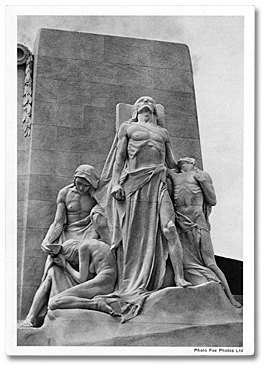
Click to see a larger image (148K)
Statue at the Vimy Memorial
Fox Photos Ltd.
Postcard
John F. Mould fonds
Reference Code: F 954
Archives of Ontario, I0024383
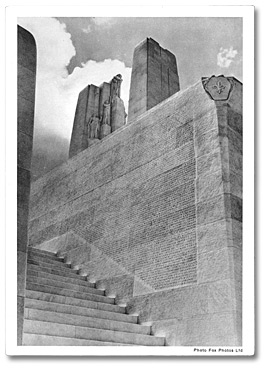
Click to see a larger image (139K)
Names on the Monument at Vimy Ridge
Fox Photos Ltd.
Postcard
John F. Mould fonds
Reference Code: F 954
Archives of Ontario, I0024384
When the King finished speaking, there was two minutes of silence, followed by the speech of the French President.
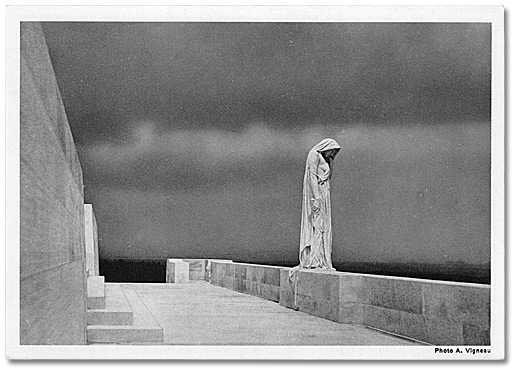
Click to see a larger image (249K)
Weeping Woman Statue at the Vimy Memorial
A. Vigneau
Postcard
John F. Mould fonds
Reference Code: F 954
Archives of Ontario, I0024382
By the end of the ceremony the pilgrims were emotionally drained. They were tired but happy to have seen this magnificent monument to the 60,000 Canadians who died in World War I, and returned to Arras contented. As John put it, almost at the very end of his journal,:
Click here to listen to an excerpt from the diary in "wav" format (355K). It is also available in "aif" format (355K).
“It was the most memorable day of our lives, and one which we shall always remember. We had made our Pilgrimage and also seen our King.”
John Mould's Diary
Excerpt from Vol. 9, pp. 69-70,
1936
John F. Mould fonds
Reference Code: F 954
Archives of Ontario
The Honourable James C. McRuer (F 1329), an Ontario lawyer, judge and author, also made the pilgrimage to Vimy Ridge in 1936. A member of his family shot 8mm movie footage of the unveiling of the monument. Click on one of the links to the right to see a clip of that material.
European trip, 1936
J. R. McRuer fonds
8 mm silent film
Reference Code: F 1329-7
Archives of Ontario
